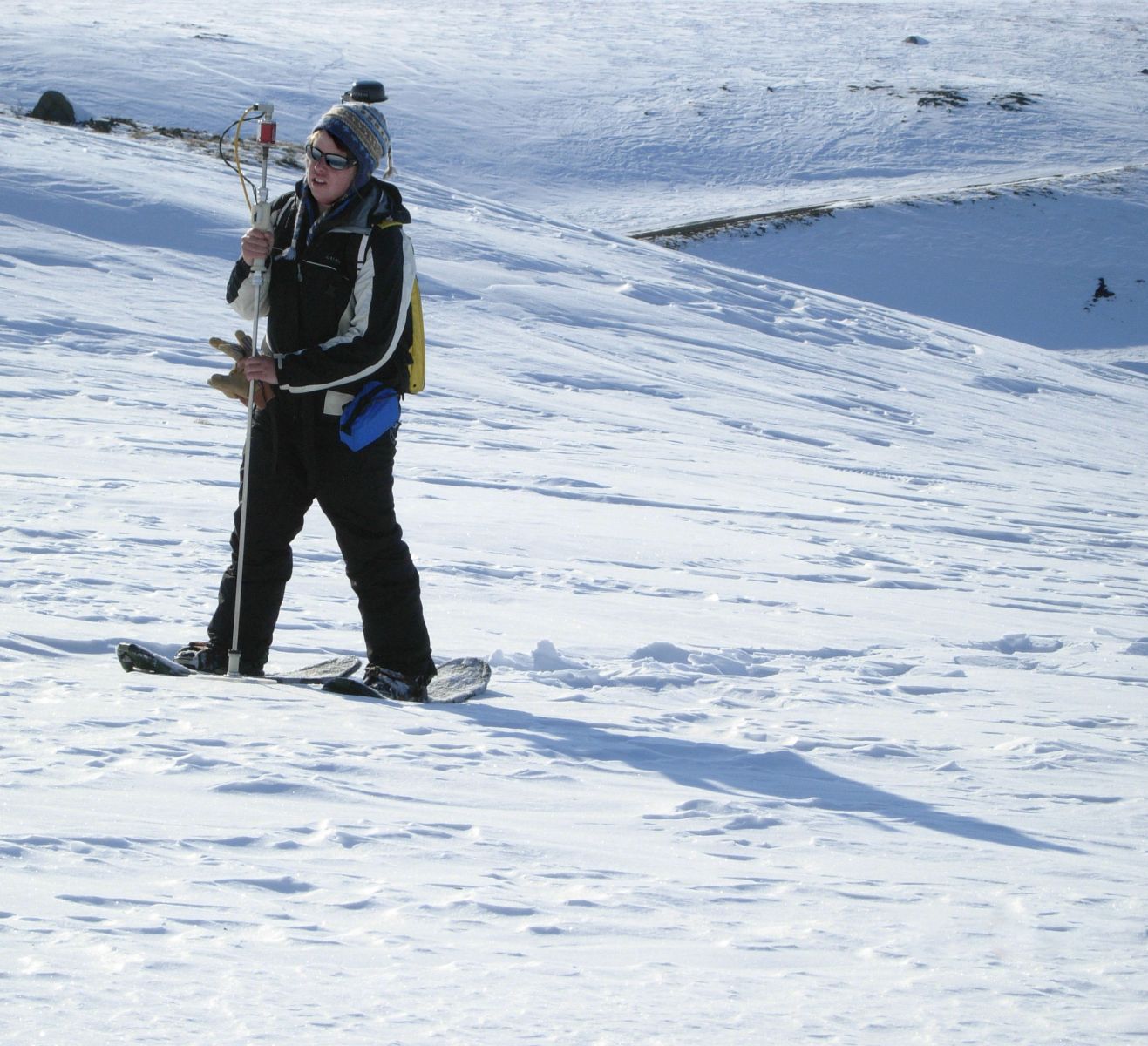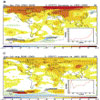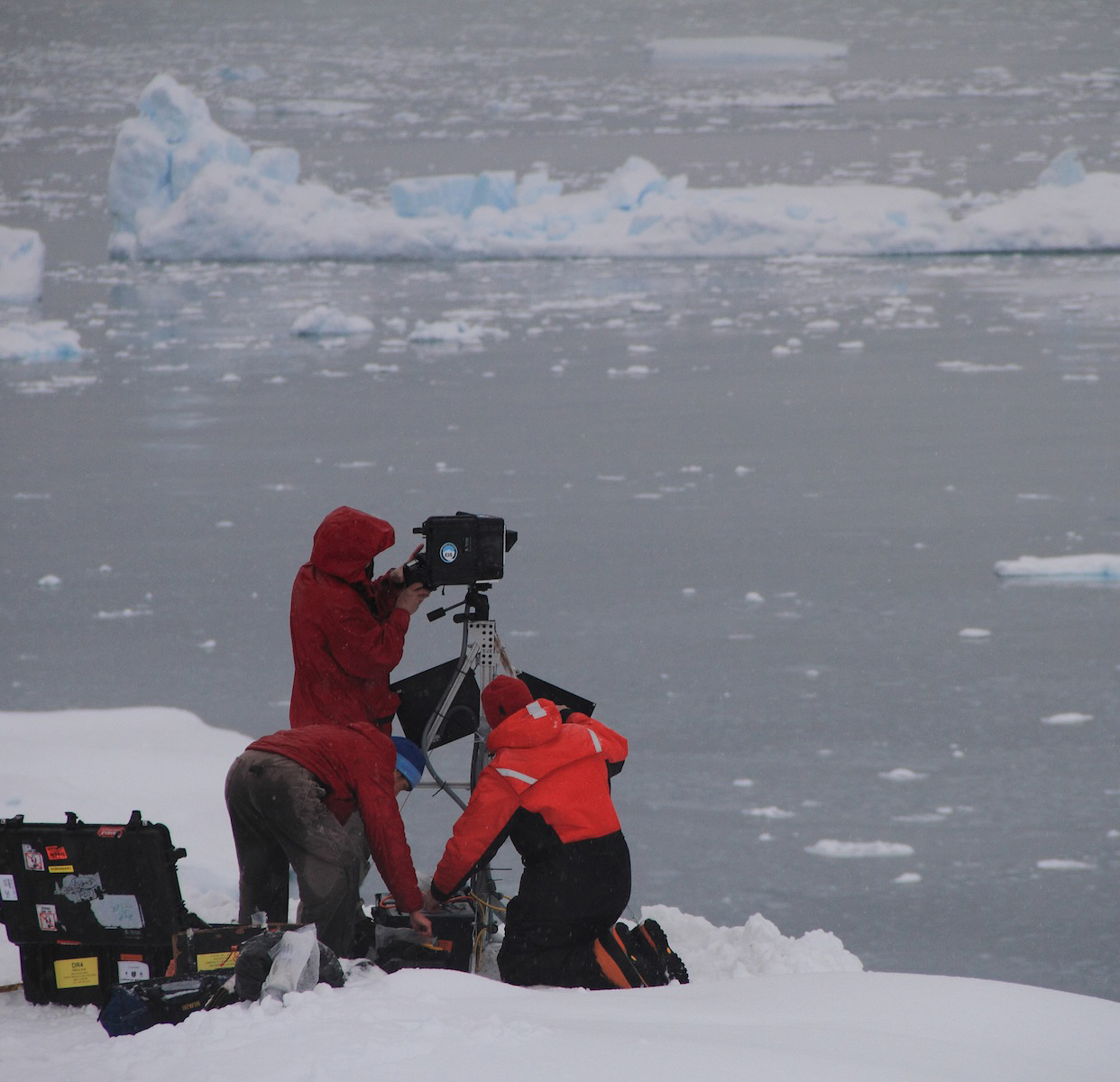Our Scientists in the Field
NSIDC scientists travel to Antarctica, Greenland, the Arctic Ocean, and the Arctic tundra to conduct field work in some of the harshest conditions on Earth. They drill ice cores, study the lay of the land beneath the Antarctic Ice Sheet, and explore first-hand how climate change is affecting the polar regions. Below, find information on ongoing expeditions and summaries of recent field work.
Ongoing Field Work

Shari Gearheard (center) enjoying tea and frozen Arctic char on the sea ice with frequent research collaborators Ilkoo Angutikjuak (left) and Kalluk Angutikjuak (right).
—Credit: G. Liston
Clyde River, Nunavut, Canada: ongoing
NSIDC scientist Shari Fox Gearheard lives and works in Kangiqtugaapik (Clyde River), Nunavut, in Arctic Canada. She works with Inuit hunters and Elders to understand Inuit knowledge of the environment and environmental change. She works to strengthen the connections between Indigenous knowledge and scientific research through coordinating collaborative teams of Inuit experts and scientists from various disciplines. Gearheard’s current projects include the Silalirijiit project, which brings together Inuit experts, scientists, and environmental modelers to investigate changing wind and weather patterns on the east coast of Baffin Island. She recently released a new book, The Meaning of Ice: People and Sea Ice in Three Arctic Communities, which documents Inuit, Iñupiat, and Inughuit knowledge and perspectives on Arctic sea ice.
More Information
Scientist Web Page: Shari Fox Gearheard
Project Web Pages: Exchange for Local Observations and Knowledge of the Arctic; Igliniit Project; Ittaq Heritage and Research Centre, Clyde River, Nunavut; Kangiqtugaapik (Clyde River) Weather Station Network; The Meaning of Ice: People and Sea Ice in Three Arctic Communities; Siku-Inuit-Hila Project; Silalirijiit project; When the Weather is Uggianaqtuq: Inuit Observations of Environmental Change
Contact: Shari Fox Gearheard
Recent Field Work
Antarctica: February 2014
The LARISSA Project, a multidisciplinary campaign to instrument and monitor change in one of the most important areas of Antarctica for climate response, has gone south again. The joint field season with the South Korean icebreaker, Araon, was excellent, and some significant work on bathymetry, oceanography, and sediment coring was accomplished, and several measurement sites that had gone silent in the past two years were repaired.
More Information
Scientist Web Page: Ted Scambos
Expedition Blog: On Thin Ice
Project Web Page: Hamilton College: LARsen Ice Shelf System, Antarctica (LARISSA)

Kevin Schaefer (right) pulls a ground penetrating radar unit through the tundra near Barrow while Andrew Parsekian records the thaw depth on a computer.
—Credit: E. Jafarov, NSIDC
Alaska: August 2013
NSIDC scientist Kevin Schaefer, NSIDC postdoctoral researcher Elchin Jafarov, and Stanford University scientists Lin Liu and Andrew Parsekian went to Barrow, Alaska to measure permafrost thaw depth using ground penetrating radar. In permafrost regions, the surface layer of soil, called the active layer, thaws each summer and freezes each winter. The ground penetrating radar emits a pulse which bounces off the frozen ground at the bottom of the active layer to give the thaw depth. This information provides valuable data to evaluate models and remote sensing products.
More Information
Scientist Web Page: Kevin Schaefer
Antarctica: April 2013
NSIDC lead scientist Ted Scambos returns to the Larsen Ice Shelf in Antarctica to maintain the network of weather and science stations that he installed during the past field seasons. Scambos and his colleagues conduct radar surveys of the Flask and Crane glaciers, installed cameras for the Extreme Ice Survey, and assist South Korean researchers in the installation of their observing stations.
More Information
Scientist Web Page: Ted Scambos
Expedition Blog: On Thin Ice
Photo Gallery: 2013 LARISSA Project
Project Web Site: Hamilton: LARsen Ice Shelf System, Antarctica (LARISSA)

Mark Serreze poses on the Arctic tundra, during the 2013 Arctic Observing Network (Snownet) project.
—Credit: M. Serreze, NSIDC
Alaska, SnowNet Project: April 2013
NSIDC scientists Mark Serreze and Drew Slater return once more to northern Alaska for the SnowNet Project. The researchers sampled snow depth and water content using a variety of different methods, including manual probing, lidar, snow pits, and snow cores. The researchers hope that the data will help them improve models of climate change in the Arctic. Matthew Sturm of CRREL leads the project.
More Information
Scientist Web Pages: Drew Slater, Mark Serreze
Photo Gallery: North Slope SNOWNET 2013

Julienne Stoeve takes sea ice thickness measurements on an ice floe in the Arctic Ocean.
—Credit: J. Stroeve, NSIDC
Arctic Ocean: August 2012
NSIDC scientist Julienne Stroeve travels to the Arctic Ocean to study sea ice at its lowest extent since satellites started measuring it in 1979. Stroeve's research expedition comes at the cusp of fundamental changes to the Arctic's sea ice cover—from older ice that is hard to melt, to seasonal ice that melts more quickly.
More Information
Scientist Web Page: Julienne Stroeve
Expedition Blog: IceEdge 2012

NSIDC graduate student Allison Hurley samples snow depth on the northern slope of Alaska during the 2012 SnowNet expedition.
—Credit: M. Serreze, NSIDC
Alaska, SnowNet Project: April 2012
NSIDC scientists Mark Serreze and Drew Slater return to northern Alaska as part of the SnowNet Project. The researchers hope that the data will help them improve models of climate change in the Arctic. Matthew Sturm of CRREL leads the project.
More Information
Scientist Web Pages: Drew Slater, Mark Serreze
Photo Gallery: North Slope SNOWNET 2012

Researchers return to the Larsen Ice Shelf in a continuation of the LARISSA Project.
—Credit: T. Scambos, NSIDC
Antarctica: November 2011
NSIDC lead scientist Ted Scambos travels back to the Larsen Ice Shelf in Antarctica to install cameras that will help scientists monitor the ice sheet. The trip is part of the NSF-funded LARISSA project, which started in 2009.
More Information
Scientist Web Page: Ted Scambos
Expedition Blog: On Thin Ice
Project Web Page: Hamilton: LARsen Ice Shelf System, Antarctica (LARISSA)

Tingjun Zhang travels to the Tibetan Plateau to measure permafrost distribution.
—Credit: T. Zhang
Tibetan Plateau: Summer 2011
NSIDC scientist Tingjun Zhang and colleagues drill boreholes over the upper reaches of Heihe River basin, Qilian Mountains in western China. The objective of this drilling is to detect permafrost distribution, study impact of frozen ground on hydrological cycle, carbon exchange. The scientists also study how climate change is affecting permafrost in the region. The drilling continues until mid-August 2011, and is supported by the Natural Science Foundation of China
More Information
Scientist Web Page: Tingjun Zhang
Contact: Tingjun Zhang

—Credit: T. Scambos, NSIDC
Antarctica: November 2010
NSIDC lead scientist Ted Scambos returns to Antarctica with the NSF-funded LARISSA project to repair and improve several of the weather and science stations that the team installed last winter. The measurement stations will help scientists record changes in glaciers and ice sheets.
More Information
Scientist Web Page: Ted Scambos
Expedition Blog: On Thin Ice
Project Web Page: Hamilton: LARsen Ice Shelf System, Antarctica (LARISSA)>

LARISSA brings together a diverse group of scientists to study the Larsen Ice Shelf.
—Credit: LARISSA project
Antarctica: Winter 2009 to 2010
NSIDC lead scientist Ted Scambos travels to Antarctica to study the Larsen Ice Shelf system as part of the Larsen Ice Shelf System, Antarctica (LARISSA) Project. LARISSA is an NSF-funded project that will examine the biology, glaciology, geology, and oceanography of the Larsen Ice Shelf system. Since the 1970s, a number of Antarctic ice shelves have broken up. In 2002, a huge section of the Larsen Ice Shelf disintegrated in the largest such event ever recorded. This had a major impact on the region, in all aspects of the Earth system. The LARISSA project researchers hope to gain insight into the factors that lead to ice shelf collapse, as well as the environmental impact of such break-up events, which may become more frequent as climate change progresses.
More Information
Scientist Web Page: Ted Scambos
Expedition Blog: On Thin Ice
Project Web Sites: Hamilton: LARsen Ice Shelf System, Antarctica (LARISSA)
Larsen Ice Shelf News
Greenland: August, 2009
NSIDC scientist Julienne Stroeve travels to the Kangerlussuaq glacier in Greenland in August, 2009. Stroeve and Asa Rennermalm, a geographer from the University of California, Los Angeles, measure the amount of water being discharged from the Kangerlussuaq glacier in south western Greenland. The research may help elucidate how climate change is affecting the mass balance of the Greenland Ice Sheet.
More Information
Scientist Web Page: Julienne Stroeve

Tim Schaefer, Lin Liu, and Tingjun Zhang drill a permafrost core near Deadhorse, Alaska. –Credit: K. Schaefer
Alaska: July, 2009
NSIDC scientists Tingjun Zhang and Kevin Schaefer travel to the North Slope of Alaska to study the carbon content in permafrost. Team members include Lin Liu, from the University of Colorado Boulder and Tim Schaefer of Schaefer Tec Consultants in Chicago. The team drilled permafrost cores near Fairbanks and six cores in a transect from Prudhoe Bay to Toolik Lake.
The researchers are working with the U.S. Geological Survey (USGS) in Boulder, Colorado to analyze the samples for carbon, ice, and mineral content. Permafrost contains a large amount of organic matter that has been frozen since the last ice age. If it thaws, the organic matter will decay, releasing carbon dioxide into the atmosphere and contributing to global warming.
More Information
Scientist Web Pages: Tingjun Zhang, Kevin Schaefer
Alaska, SnowNet Project: June, 2009
NSIDC scientists Mark Serreze and Drew Slater head to northern Alaska as part of the SnowNet Project. The researchers sampled snow depth and water content using a variety of different methods including manual probing, lidar, snow pits, and snow cores. The researchers hope that the data will help them improve models of climate change in the Arctic. Matthew Sturm of CRREL leads the project.
More Information
Scientist Web Pages: Drew Slater, Mark Serreze
Norway-U.S. Scientific Traverse of East Antarctica: Winter 2008 to 2009
NSIDC lead scientist Ted Scambos participates in the Norway-U.S. Scientific Traverse of East Antarctica. The team of scientists from the United States and Norway begin their journey at the South Pole in November of 2008, and travel about 1,000 miles to the Norwegian base at Troll Station. The year before, University of Colorado graduate student Atsuhiro Muto participated in the first leg of the traverse, which went from Troll Station to the South Pole. The project maps the ice sheet elevation and thickness in never-before-visited regions, extracted ice cores to look at the past 2000 years of climate, and investigated ongoing ice motion and climate change effects in East Antarctica.
More Information
Scientist Web Pages: Ted Scambos
Project Web Page: Norway-U.S. Scientific Traverse of East Antarctica
 Scientists
Scientists Research Grants
Research Grants Scientific Publications
Scientific Publications Informatics Research
Informatics Research NSIDC Scientific Expeditions
NSIDC Scientific Expeditions Scientists blog from Antarctica and provide a glimpse of what it's like to do research in the field.
Scientists blog from Antarctica and provide a glimpse of what it's like to do research in the field. 









